

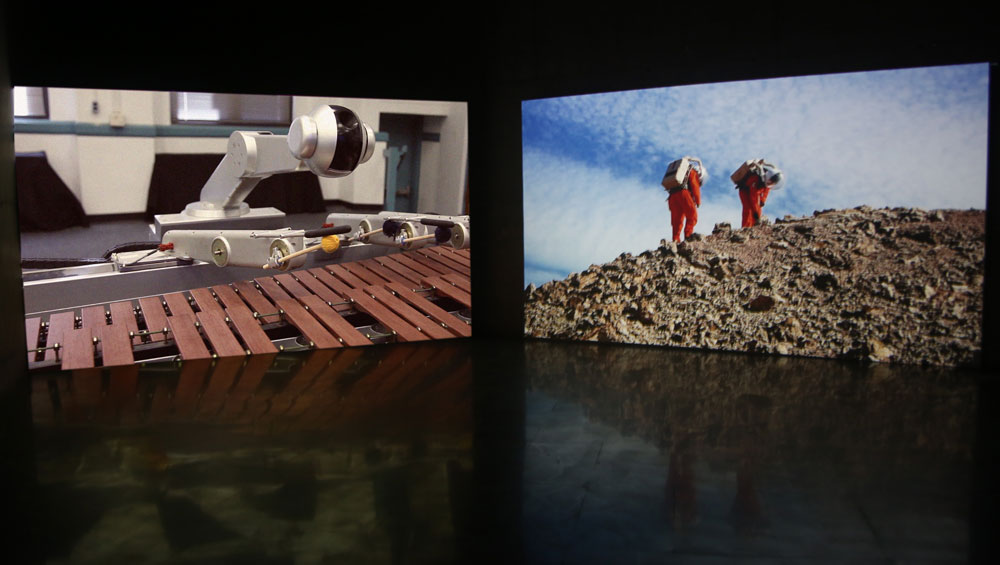
Museo de la Naturaleza y el Hombre, Santa Cruz de Tenerife, Spain
and
Museo de la Ciencia y el Cosmos, La Laguna, Tenerife, Spain
14 November 2018 – 14 January 2019
by LILLY WEI
The American video and performance artist and photographer Janet Biggs is known for her daring as she travels the world, often to hazardous, politically contested locales in order to learn and experience firsthand how we, its denizens, survive its more inhospitable zones. She then films what she sees – with stunning results.
Seeing Constellations in the Darkness between Stars (excerpt).
Her films are characterised by a breathtaking grandeur, capturing unearthly landscapes such as rivers of seething, brilliantly coloured lava, blank sand deserts rippled by minimalist patterns, cloud-piercing mountains, glistening Arctic ice fields and deep tunnels burrowing into the earth. What also characterises Biggs’s production is the search for refuge, shelter and sustenance, for human presence and imprint within the harshest environments, her point of view making such terrain more comprehensible, more intimate, intensifying and enriching the narrative through unexpected visual associations that add breadth, nuance and, ultimately, poetry. She is not a documentary film-maker.
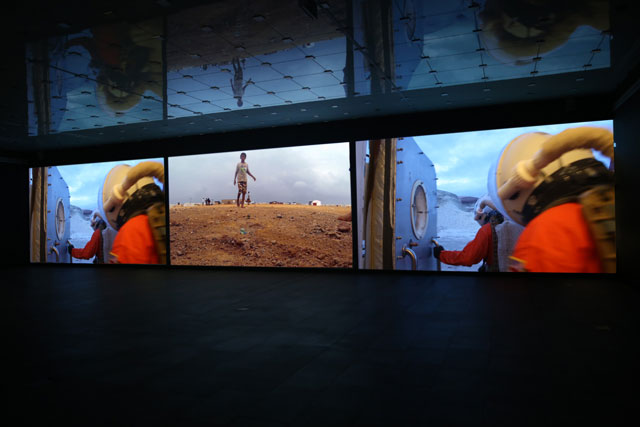
Janet Biggs, Weighing Life Without a Scale, 2018. Three-channel HD video installation with sound. Installation view at Museo de la Naturaleza y el Hombre. Courtesy of the artist, Cristin Tierney Gallery, New York, NY, Analix Forever, Geneva, Switzerland, and CONNERSMITH, Washington, DC. Photo: Robert Cmar.
Biggs’s three new films, each about eight minutes long, are some of her most ambitious to date. In crystalline high-definition, they took four years to complete and debuted in Tenerife, Spain, in mid-November. Presented under the evocative title Like Walking on Mars, all three are interlinked, a kind of mini-series, say, with footage she took of the Mars Desert Research Station in Utah simulating conditions on Mars, the linchpin in her nature, culture and science triumvirate and emblematic of the most extreme of terrains. The videos are shown, appropriately, in two science museums. Ideally, it would have been wonderful to install all of them in the same venue, brought together for maximum continuity and impact. That said, they still had more than enough punch on their own. At the Museo de la Naturaleza y el Hombre in Santa Cruz de Tenerife, Weighing Life Without a Scale, a three-channel projection, stretches out over one entire wall of the exhibition space. Serendipitously, the videos are mirrored in the reflective panels that cover the ceiling, transforming the gallery into an encompassing, slightly discombobulating infinity room.
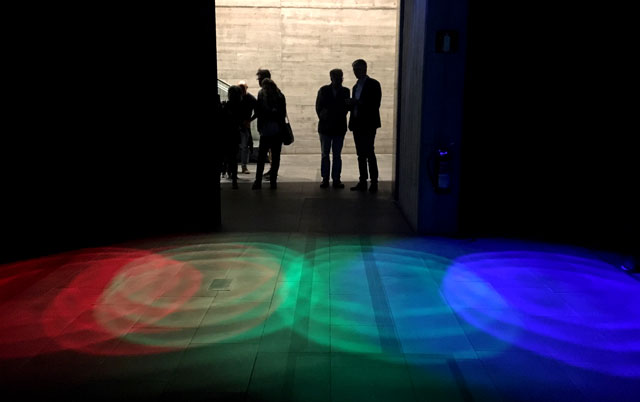
Janet Biggs, Spectrum, 2018. Light sculpture, size variable. Installation view at Museo de la Naturaleza y el Hombre. Courtesy of the artist, Cristin Tierney Gallery, New York, NY, Analix Forever, Geneva, Switzerland, and CONNERSMITH, Washington, DC. Photo: Candace Moeller.
You enter by stepping on a projected rainbow of colours splashed on to the floor at the entrance, signalling the crossing into another realm. The theme is walking, movement, with its implications of displacement, relocation and quest. You are struck by all the walking, of people purposefully striding within the screen and from screen to screen as the images flow, the intercutting adding thrust, energy and message.
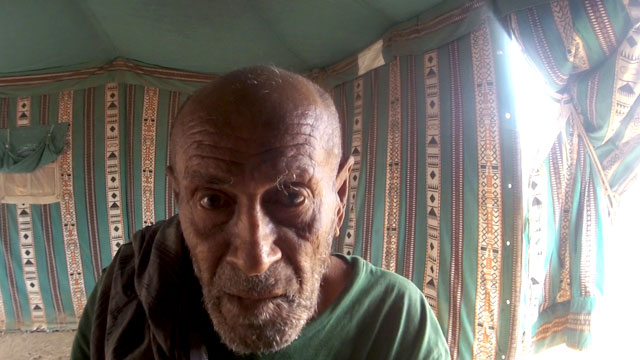
Janet Biggs, Weighing Life Without a Scale, 2018 (detail). Three-channel HD video installation with sound. Courtesy of the artist, Cristin Tierney Gallery, New York, NY, Analix Forever, Geneva, Switzerland, and CONNERSMITH, Washington, DC.
It opens with a recitation by an old Yemeni poet, then scenes of Yemeni men in a refugee camp in Djibouti walking down a dirt road, followed by pictures of observatories and other buildings in the Mars research station and a crew (including the artist) also walking, then a woman from the camp clad in a black burqa rushing along, and running children playing a game of marbles, the orbs glittering green like tiny verdant worlds, explosively colliding with each other in a symbolic act of creation or destruction. Biggs had taught some of the youths in the camp to use video cameras, and the conclusion focuses on the contagious, improbable joy of a young girl, Saeeda Ahmed Abdo Haidra, singing and dancing, filmed by Iqbal Mohamed Abdo Saeed, a Biggs tutee, and one of her many collaborators on this project. It ends on a note of hope, on the purer aspects of the human spirit, however difficult it is to keep that hope alive in what seems our Hobbesian global moment.
The sound track for the video is also terrific, with original compositions by musicians Anna Savery, Richard Savery and William Martina. The score (accompanied by sounds such as wind that lend their own music to the mix) is integral to the unspooling visuals. It is often haunting, emphasising the loneliness of her chosen places, and adds momentum, emotional and psychological depth, and even scale, to the narrative, assuming, as a subject, an even more prominent role in this body of work.
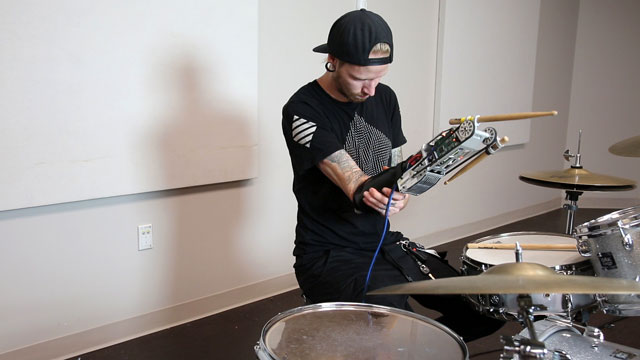
Janet Biggs, Seeing Constellations in the Darkness Between Stars, 2018 (detail). Four-channel, HD video installation with sound. Courtesy of the artist, Cristin Tierney Gallery, New York, NY, Analix Forever, Geneva, Switzerland, and CONNERSMITH, Washington, DC.
The other venue is the Museo de la Ciencia y el Cosmos in nearby La Laguna. Equally stunning, the projections here consist of a four-channel and a two-channel video installation, the filmed locations similar with the addition of a music studio. The former, Seeing Constellations in the Darkness between Stars, focuses on the interdependency of art and science, specifically music and technology. Jason Barnes, a drummer who uses a prosthetic limb following the amputation of his lower arm, is shown expertly playing with both his whole and prosthetic arm. As the film progresses, there is a scene in which his artificial limb is contrasted briefly with the arm of a Mars Rover in the adjacent screen. They are very similar and serve as a glimpse into the future in which the human and the technological might be so merged that they are interchangeable in ways we can’t yet imagine. What we think is still in the realm of science fiction will soon be reality, if it isn’t already.
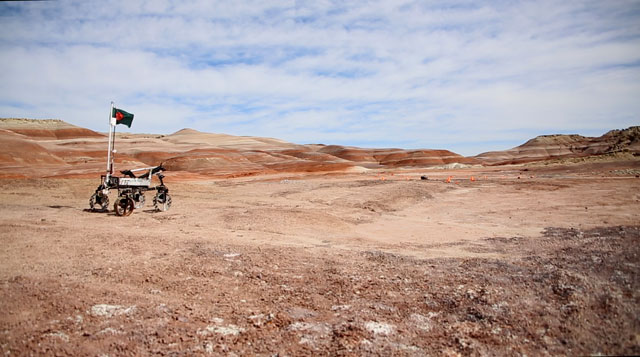
Janet Biggs, Seeing Constellations in the Darkness Between Stars, 2018 (detail). Four-channel, HD video installation with sound. Courtesy of the artist, Cristin Tierney Gallery, New York, NY, Analix Forever, Geneva, Switzerland, and CONNERSMITH, Washington, DC.
Space Between Fragility Curves also spotlights music. The lead performer in this video is Shimon Robot. And who/what is Shimon Robot? It (he/she/they?) is a perky, charismatic silver knob of a robot whose musical talent, its artificial intelligence, was programmed by Richard Savery. This video opens with two Yemeni boys setting out toward an endless horizon on a makeshift raft, reminding us of all the perilous journeys undertaken by refugees, and goes back and forth between them, the Mars Desert Research Station’s crew, and the music studio. Shimon does a star turn playing an original composition on the marimba that might be the celestial harmonies that were once believed to be the sound created by the rotation of the planets around Earth.
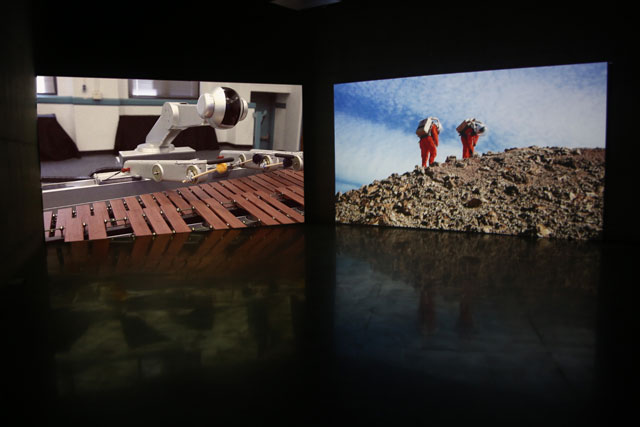
Janet Biggs, Space Between Fragility Curves, (installation view at Museo de la Ciencia y el Cosmos) 2018. Two-channel, HD video installation with sound. Courtesy of the artist, Cristin Tierney Gallery, New York, NY, Analix Forever, Geneva, Switzerland, and CONNERSMITH, Washington, DC. Photo: Robert Cmar.
Biggs’s camera eye is wide, inquiring, absorbing the horizon, the sea and the sky, but then, it can tighten, zooming in on details, on the personal. And it is this very singular combination of the romantic drawn to adventure and the sublime coupled with the reporter’s acuity and the witness’s sensitivity that makes her films so entirely original, so utterly compelling.
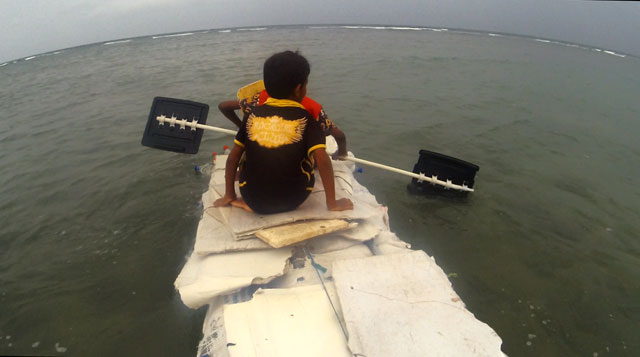
Janet Biggs, Space Between Fragility Curves, 2018 (detail). Two-channel, HD video installation with sound. Courtesy of the artist, Cristin Tierney Gallery, New York, NY, Analix Forever, Geneva, Switzerland, and CONNERSMITH, Washington, DC.